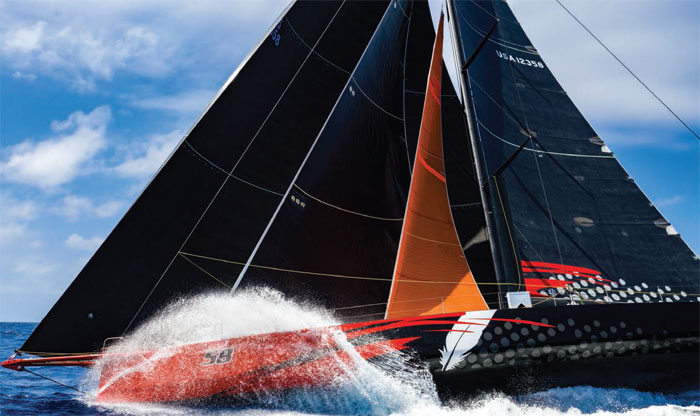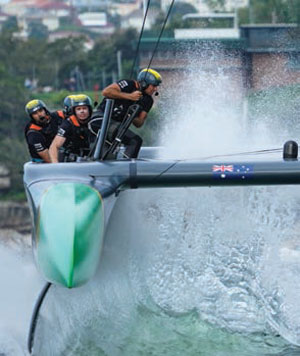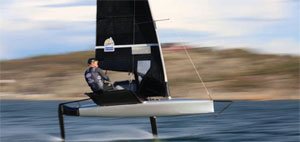

There is no let up in the queue of top international sailing talent lining up to join the literally ‘fizzing’ performance team at Doyle Sails... America’s Cup, SailGP and Volvo veteran Kyle Langford is just the latest
A brief exchange during a training session aboard the supermaxi Comanche ahead of the 2019 Sydney Hobart race provided Doyle Sails with one of those rare sparks that add impetus to company strengths and change individual career paths. It illustrates Doyle’s drive to build a formidable talent pool of top sailors to develop, refine and test new technologies while helping customers sail faster towards achieving their goals.
The Comanche moment came in one of those periods when the boat is settled in its groove, the breeze is steady and the crew, perched along the rail, can briefly catch their breath. Kyle Langford, a young Australian trimmer who had already packed two America’s Cup campaigns and a Volvo Ocean Race into his career, was chatting to fellow Moth sailor Tom Johnson about ideas for a new sail design. Taking advantage of the lull in activity, Doyle Sails CEO Mike Sanderson made his way forward and slotted into the line-up on the side deck. Langford asked if Doyle was doing any work in the Moth class.
‘We are very keen to get involved,’ Sanderson replied, ‘but we’re looking for somebody to work with.’ ‘Well,’ said Langford, ‘we’re definitely your guys.’ The resulting collaboration led to a podium finish at the next Moth worlds and a job for Langford at Doyle Sails.
For Langford that day on Comanche had already been an epiphany about Structured Luff technology. ‘It was an absolute revelation,’ he recalls. ‘The first time we set the new Structured Luff J1, the load on the headstay went from 20 tons with the previous sail to 14 tons for the same luff projection. It was unbelievable.’
He immediately grasped the implications. ‘If you reduce loads by more than 25%, you can reduce the structure in the boat and rig by 25%. It all gets smaller and lighter and the performance gains are huge.
‘Just reducing the load was a big gain on Comanche, but if you start from scratch, it can revolutionise the way boats are designed and built.’
In the three years since, Langford has won two SailGP championships as wing trimmer with the Australian team led by Tom Slingsby. The Doyle Sails synergy continues in that fastpaced arena, with Doyle providing one-design headsails for the fleet.
Langford’s recruitment shows how Doyle Sails targets the world’s best sailors in support of its “By Sailors for Sailors” ethos and its determination to keep freshening the pool with a younger generation of stars.
‘I already knew about Kyle’s racing record,’ says Sanderson. ‘Beyond that, what impressed me was his technical intelligence, his clear understanding of what makes a boat go fast and his ability to communicate his thoughts and ideas, which is invaluable for technical design and development.
‘He clearly had the drive to succeed and would be an asset both within the Doyle Sails culture and crucially in helping our customers achieve their performance goals.’
Langford has always been younger than his sailing peers. ‘I’ve been fortunate that throughout my career, I have always been the young one, so I’ve had more experienced people to learn from,’ he says.
He grew up in a sailing family based around Lake Macquarie YC north of Sydney. ‘My brother Mark is four years older. When he was eight, he was able to join sailing lessons but I was not happy just watching on.’
Kyle was so insistent that the club made a special exemption to enable him to start lessons alongside his brother at just four years old. ‘After about 10 years, our sailing started getting more competitive,’ he recalls. ‘When I was 14 or 15, I was not loving school. I preferred being on the water, so I looked for every opportunity to go sailing.’
At that stage he was sailing with Evan Walker in 29ers and eyeing the Youth World Championships. But the selected 420 dinghy hardly lit their fire, so they switched to multihulls and started training in Hobie 16s.
‘Evan was in Sydney, a two-hour drive south of Lake Macquarie. So for about nine months my mother would pick me up from school two days a week and drive me to Sydney for training sessions. I also spent every weekend in Sydney.’
Though they had little opportunity for high-level racing in this period, Langford and Walker headed for South Korea and won the Hobie 16 youth worlds. ‘That was my first big international competition and I decided there and then that I wanted a career in sailing.’
Youth match racing, Laser and 18ft Skiff racing followed while he ground out his final school years before rejoining Walker in an Olympic Tornado campaign.
In 2007, they headed to Portugal for the Tornado worlds. ‘Our results were forgettable,’ Langford laughs, but their Tornado programme was soon dashed anyway when the class was dropped from the Olympic slate.
However, the America’s Cup that was taking place in neighbouring Spain caught his eye. ‘I had not followed it closely up to then but with the Olympic goal out of the picture, I decided to do everything I could to get involved with the Cup.’
After several years of racing in a variety of disciplines, his AC chance came when he was racing RC44s with Jimmy Spithill, who offered him a position with Oracle Racing. Langford was just 21 years old.
‘I clearly remember my first day with Oracle. Although I had been doing quite well up to then, including match racing with some success against AC sailors, I realised how little I really knew about sailing. I had no idea how much I didn’t know until I joined Oracle. Luckily I was the youngest member of the team by 10 years, so again more experienced guys took me under their wing and opened my eyes to the technical and development side of the sport.’
The 2013 America’s Cup in San Francisco was meant to be his apprenticeship, as understudy to wing trimmer Dirk de Ridder. That plan dramatically changed when, just three days before the opening race of Oracle’s AC defence, Langford found himself propelled onto the A-boat in the crucial wing-trimmer role.‘For sure I was nervous,’ he admits, ‘but, probably naively, I was confident I could do a good job.’
It was an extraordinary event, with Oracle storming back from 8-1 down against ETNZ to win the Match 9-8 and retain the Cup. At 24, Langford was a Cup winner. Four years later he felt the pain of losing the Cup against the Kiwis in Bermuda but the personal gains were hgue. Although Langford was, by his own admission, not a star pupil at school, he never lacked ambition or a driving thirst for knowledge; he saw his America’s Cup experience as his master’s degree in sailing.

Above and below: Langford’s many other successes include two SailGP wins and a second place at the 2020 International Moth world championships

‘It would be such a missed opportunity if you were around so many brilliant minds across so many specialist fields and you failed to learn as much as possible from them. I have found in the sailing world that if you show an interest in any area, no matter how advanced their formal qualifications might be, the experts are always very helpful and forthcoming in passing on that knowledge. I have been very lucky to take advantage of that. It has provided a good foundation for my career going forward.’
The next big-ticket item on Langford’s a busy to-do list was to race around the world. Straight off the Bermuda America’s Cup, Langford found himself donning sea boots and foul weather gear for the Volvo Ocean Race with Bouwe Bekking’s Brunel team.
Once again this was foreign territory. ‘At that point, I had never sailed through the night before, cruising or racing. I had never done a Sydney-Hobart Race, or really gone offshore.’
One senses that this was not a passion project but more of that drive to complete the entire curriculum of his sailing education. Accordingly, by the age of 30 his CV included a world dinghy title, Moth worlds silver medal, RC44 match race champion, an America’s Cup win, two-time SailGP champion and a podium finish in an ocean race around the world.
There is a pattern here of setting high goals and achieving them. To that extent, Langford’s professional sailing credentials are beyond question. When it comes to helping a team or campaign develop a successful performance package, however, the real added value lies in the ability to translate those credentials into vital intelligence to drive the process forward.
‘Regardless of whether you are using a solid wing on an AC50, or a mainsail on a TP52, the balance you are trying to achieve and the general concepts are the same,’ he says. ‘At the end of the day, you want to maximise drive and minimise drag. You can jump on any boat and, through experience, straightaway feel if the sails are good or bad. With a fundamental understanding of the physics of sailing and the engineering behind the building of sails, you need to identify the factors impacting their performance and what can be improved.
‘Just saying it is bad is unacceptable. Helping to figure out the solutions and providing solid feedback to the design team is what makes a good development sailor. If you are struggling for height, for example, you probably have too much drag. An adjustment of just a couple of millimetres can make a huge difference in terms of luff curve, or broadseam shape.
‘My goal is always to be on the fastest boat. When I am part of a team, it is always about looking for that last per cent of performance. Partnering with Doyle Sails gives me access to the best designers and technology in the world as well as some of the best sailors in the world.
‘The first time we put up that Structured Luff sail on Comanche, I was impressed to be working with the guys who came up with the original concept. And the best part is that there is still plenty more development to come. I am excited to be part of that process.’
For Doyle CEO Mike Sanderson, the strategy is clear: ‘Kyle’s extraordinary story is a part of our philosophy of gathering the best expertise in all aspects of the endeavour – design, technology, materials, sailing performance – and using the combined power of that knowledge and experience to keep improving.
‘That way, everybody keeps lifting the game and the whole becomes much greater than the sum of its parts.’
Click here for more information on Doyle Sails »
We invite you to read on and find out for yourself why Seahorse is the most highly-rated source in the world for anyone who is serious about their racing.
To read on simply SIGN up NOW
Take advantage of our very best subscription offer or order a single copy of this issue of Seahorse.
Online at:
www.seahorse.co.uk/shop and use the code TECH20
Or for iPad simply download the Seahorse App at the iTunes store


